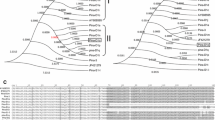Abstract.
Japanese green tea cultivars and 463 local tea plants including mountainous tea, yama-cha, were analyzed to determine the process of differentiation of Japanese tea plants using phenylalanine ammonia lyase (PAL) as a DNA marker. The main DNA fragments detected by RFLP analysis, which were named A, B and D, were inherited as multiple allelic genes at one locus. Japanese tea cultivars were divided into five groups according to RFLPs: AA, AB, AD, BD and DD. The AA group included many cultivars selected from local tea plants. The BD group consisted of cv Yabukita or descendants from Yabukita produced by artificial crossing. There was no BB group of cultivars. Allelic frequencies of A, B and D were 0.66, 0.08 and 0.22, respectively, and these values were same in tea plants collected from all regions of Japan. Since the frequencies in yama-cha and local tea plants were also the same, it is thought that these teas have the same origin. These results indicate a process of differentiation from the ancestral material presumably introduced from China to the local tea plants and, finally, cultivars which were produced by selecting from local tea plants and crossing.
Similar content being viewed by others
Author information
Authors and Affiliations
Additional information
Electronic Publication
Rights and permissions
About this article
Cite this article
Matsumoto, .S., Kiriiwa, .Y. & Takeda, .Y. Differentiation of Japanese green tea cultivars as revealed by RFLP analysis of phenylalanine ammonia-lyase DNA. Theor Appl Genet 104, 998–1002 (2002). https://doi.org/10.1007/s00122-001-0806-z
Received:
Accepted:
Issue Date:
DOI: https://doi.org/10.1007/s00122-001-0806-z




